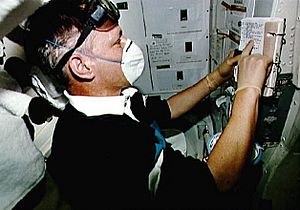Corrective maintenance facts for kids
Corrective maintenance is like fixing something after it breaks. It's a type of maintenance where you find out what's wrong with a machine or system, fix it, and get it working again. The goal is to make sure the equipment can do its job properly, just like it did before it broke.
Contents
What is Corrective Maintenance?
Corrective maintenance happens after a problem is found. Its main goal is to repair something that has stopped working. This brings the item back to a state where it can do what it's supposed to do.
There are two main types of corrective maintenance:
- Immediate corrective maintenance: This is when work starts right away after something breaks. For example, if a school computer crashes during class, someone tries to fix it immediately.
- Deferred corrective maintenance: This is when the repair work is put off until later. This might happen if the broken item isn't super important right now, or if fixing it immediately would cause bigger problems. For instance, a small crack in a non-critical part of a building might be fixed during a planned maintenance period.
Why Choose Corrective Maintenance?
Deciding to use corrective maintenance depends on a few things. Companies think about:
- Cost of downtime: How much money or time is lost if the equipment isn't working? If it's not much, they might wait for it to break.
- Reliability: How often does the equipment usually break? If it's very reliable and rarely breaks, waiting for a fix might be okay.
- Backup systems: Is there a spare machine or system that can take over if one breaks? If so, waiting for a repair is less risky.
How Corrective Maintenance Works
When something breaks, corrective maintenance usually follows a set of steps:
- Find the problem: First, you figure out exactly what went wrong. This is called diagnosis.
- Remove the broken part: Once you know the problem, you take out the part that caused the failure.
- Get a new part: You order or find a replacement for the broken part.
- Install the new part: You put the new part into the machine.
- Test it: You check to make sure everything works correctly after the repair.
- Continue using: If the tests are good, the equipment goes back to normal use.
New technologies, like those in Industry 4.0, are making corrective maintenance better. They can help by keeping a history of the device, showing common ways things break, giving advice on how to fix them, and even telling you if spare parts are available. This makes fixing things faster and easier.
See also
- Preventive maintenance
- Predictive maintenance
 In Spanish: Mantenimiento correctivo para niños
In Spanish: Mantenimiento correctivo para niños


